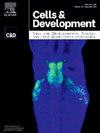从人类扩增潜能干细胞中生成肾脏器官组织。
IF 2
4区 生物学
Q4 Biochemistry, Genetics and Molecular Biology
引用次数: 0
摘要
人类扩增潜能干细胞(hEPSC)的建立为肾类器官的转化研究提供了一个独特的细胞平台。我们使用CRISPR-Cas9在hEPSC细胞系中产生SIX2报告基因和多西环素(DOX)诱导的YAP过表达。在培养液中分别加入化合物和DOX诱导Hippo-YAP信号传导。含有SIX2- mcherry报告基因的hEPSC细胞系在体外准确地反映了SIX2的表达,从而能够实时跟踪肾脏类器官的发育。对比分析显示,在肾元祖细胞(NPC)生成前抑制Hippo-YAP信号通路可有效增加NPC的数量,导致更像肾元的结构。然而,长期抑制阻碍了肾类器官的进一步成熟,导致分化停滞。因此,在NPC生成之前激活YAP有助于其成熟,为提高肾脏类器官分化效率提供了有效的诱导策略。本文章由计算机程序翻译,如有差异,请以英文原文为准。

Generation of kidney organoids derived from human expanded potential stem cells
The establishment of human expanded potential stem cell (hEPSC) presents a unique cellular platform for translational research in kidney organoids. We generated SIX2 reporter and doxycycline (DOX)-inducible YAP overexpression in hEPSC lines using CRISPR-Cas9. Chemical compounds and DOX were added to the culture medium to induce Hippo-YAP signaling, respectively. The hEPSC line containing the SIX2-mCherry reporter gene accurately reflected SIX2 expression in vitro, enabling the real-time tracking of kidney organoid development. A comparative analysis revealed that inhibiting the Hippo-YAP signaling pathway before nephron progenitor cell (NPC) generation effectively increased the number of NPCs, resulting in a more nephron-like structure. However, prolonged inhibition hindered the further maturation of the kidney organoids, leading to differentiation stagnation. Therefore, activating YAP before NPC generation facilitates their maturation, offering effective induction strategies improving kidney organoid differentiation efficiency.
求助全文
通过发布文献求助,成功后即可免费获取论文全文。
去求助
来源期刊

Cells and Development
Biochemistry, Genetics and Molecular Biology-Developmental Biology
CiteScore
2.90
自引率
0.00%
发文量
33
审稿时长
41 days
 求助内容:
求助内容: 应助结果提醒方式:
应助结果提醒方式:


